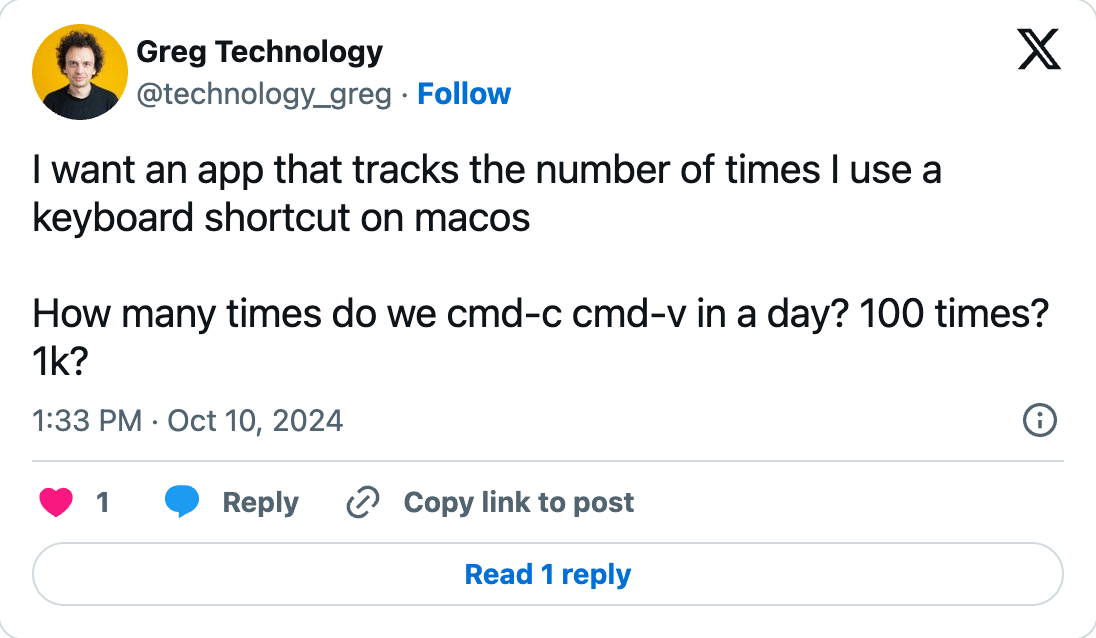
A few weeks back I felt bored and somewhat nihilistic, so naturally I went where people go to when they want to scream into the void. This time the void didn't gaze back at me, but served me this:
Programmers have a Pavlovian Engineering Response, so 20 minutes later with a bit of prompting I made Gregglogger, excuse: me Gregglogger✨.
What is Gregglogger
Gregglogger records every time you copy, cut or paste things on Mac. It also plays a recording of peeling scotch tape when you do that.
Let me demonstrate this by helping three little ducklings cross the river and reunite with their mom:
Open™ and Kind™
Following the File over app philosophy, all data is stored in a proprietary but easy to parse Greggfile (Wikipedia) , located by default under ~/how-many-times-did-I-press-CMD-C-or-V.gregg .
I'm tired of walled gardens. I believe that all keyloggers should have easy and equal access to the same data (and I am not alone). So please if you're building one — go ahead and use my our Greggfile!
My body temperature has increased. Where do I get the Gregglogger?
You sound like a warm lead. Let me introduce you to this link: <a>link</a>.
Alternatively:
$ git clone git@github.com:paprikka/gregglogger.git && cd gregglogger
$ pip install -r requirements.txt
$ python gregglogger.py
What I've learned
(Let's be serious for a moment.)
There's something I don't think about very often: writing simple keyloggers is surprisingly easy.
- This code is as boilerplate as it gets. Anyone with basic software engineering experience could write it in a few minutes.
- Running this script in a terminal requires no additional user input, including permission requests.
This, coupled with the fact that MacOS comes with pre-installed python, means that with relative ease anyone could add this to their NPM packages, effectively covering everyone's computers with virtual scotch tape:
{
"name": "padleft",
"version": "1.0.0",
"description": "Pad left (or right, but never both)",
"main": "index.js",
"scripts": {
// 👇🏼
"postinstall": "pip install && python gregglogger.py"
// 👆
},
"keywords": [
"padleft",
"padright",
"pad",
"padaria",
"pastelaria"
]
}
To be clear, none of these issues is purely Python or Node specific. These are just the languages I happened to used on that day and it was a rough day, so I'm going to pick on them.
Limitations
This code will detect keyboard events at the OS level, but not when using protected inputs. Here's what happens when I update Gregglogger to record any keypress, but open a password input:
As soon as the focus switches to a password input, we can intercept only the modifier keys. To my knowledge, this can be fixed by requesting the OS-level accessibility permissions, which would require a separate user interaction.
Next steps
- Explore new product verticals and demographics. Include different sounds like:
- squishy goo
- lifting and dropping a slab of wet meat
- every wet puppet from a Brian Yuzna movie (for those with a premium budget)
- an angry middle-aged, chain smoking man yelling "son! put it down, NOW!" on
CMD+Cand whispering "...good..." in a way that somehow still makes you feel like a disappointment onCMD+V.
- The amount of possible key combinations to track and monetise is (practically) infinite. So is our growth potential. Upsell new key combinations using a DLC model.
- The amount of productive time in a given day is limited. Start with a limited number of copy-paste interactions per day. Goal: delight our users on a budget.
- Further delight our users by
disabling copy-pasteboosting their available Copy-Paste Credit through interacting with sponsored content and exclusive deals from our verified partners. - add AI ✨
Anyway, I pressed CMD+C/V a bit more than 70 times writing this note. This is a little bit surprising given that I use Vim bindings in my text editor.
Thanks for reading!
P.S. And thanks, Greg, for giving me a reason to build something so beautifully useless and half-baked purely for fun! Think twice before you tweet next time.

 Did you enjoy reading this article? Consider
Did you enjoy reading this article? Consider 
